What is Content Strategy and How to Develop One in 6 Steps?
About 82% of marketers are actively using content marketing. And almost 40% view content marketing as a crucial aspect of their overall marketing strategy.
Sure content marketing is important. But without a solid content strategy, you’ll not realize the full potential of content marketing and all it offers.
But what is content strategy and why is it important?
Find the answers to these questions and more in this post.
You will learn:
- What is content strategy?
- Why a content strategy is important for your business
- How to create an effective content strategy
Sounds interesting?
Keep reading.
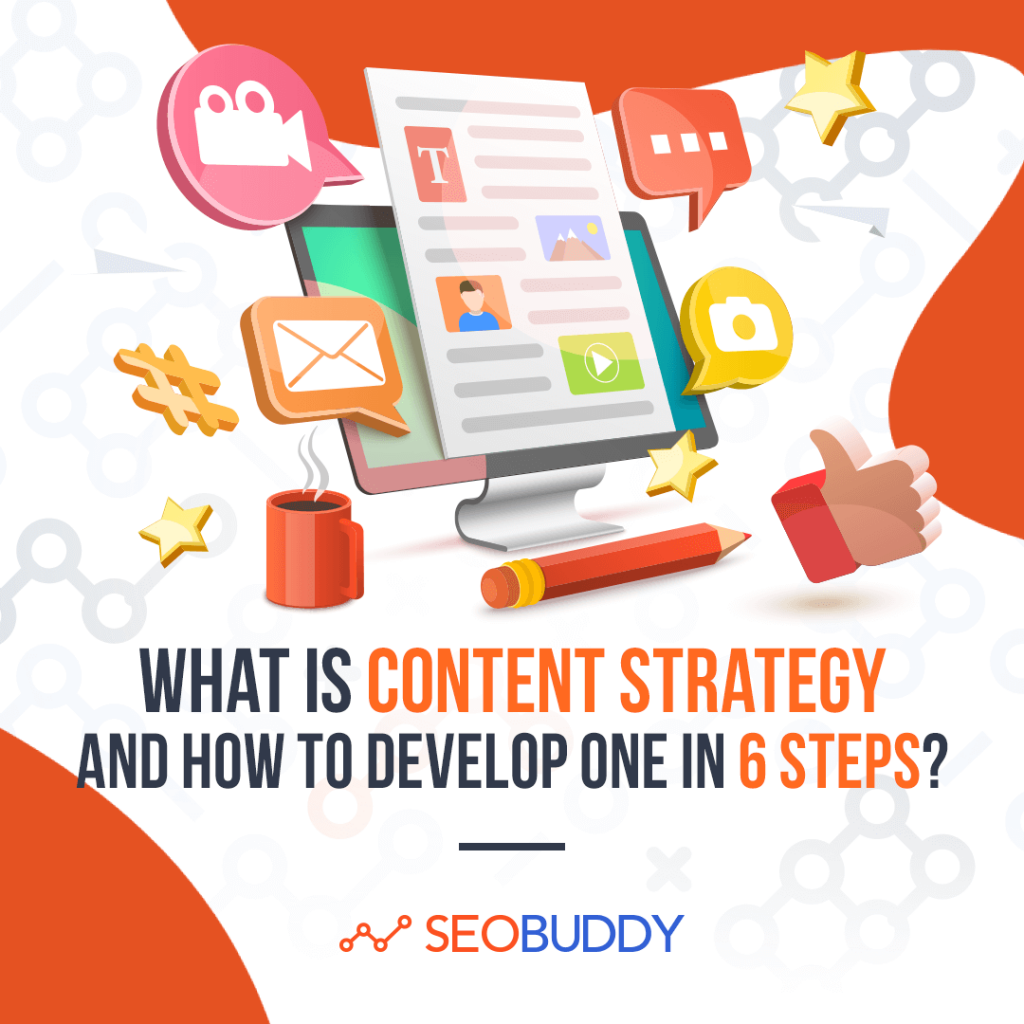
What is Content Strategy?
Content provides an effective way to help your customers discover and engage with your brand without relying on push advertising techniques like banner ads.
The discovery happens when the customer makes a search query and finds the answers in your content.
Content also shows your target customers that you’re an expert in your niche, and once they decide to buy, they’ll trust your brand to offer a fitting solution.
So, what is content strategy?
Content strategy is your plan of action for the creation and publication of content to achieve your business objectives.
You don’t just create content but have a “why” behind the content creation and this provides a more definitive answer to “what” you should create. Consider crafting a content map to strategically target publishing content that will resonate with your audience.
Content strategy can help you plan and target your content in a way that drives results.
Let’s discuss the benefits of having a content strategy in the next section.
What Makes a Content Strategy So Important?
A content strategy makes your content marketing efforts goal-driven, instead of it being directionless.
It helps you set the right priorities and ensure that the effort your content team puts in will deliver tangible results.
Let’s look at some of the business objectives a content marketing strategy can help you achieve.
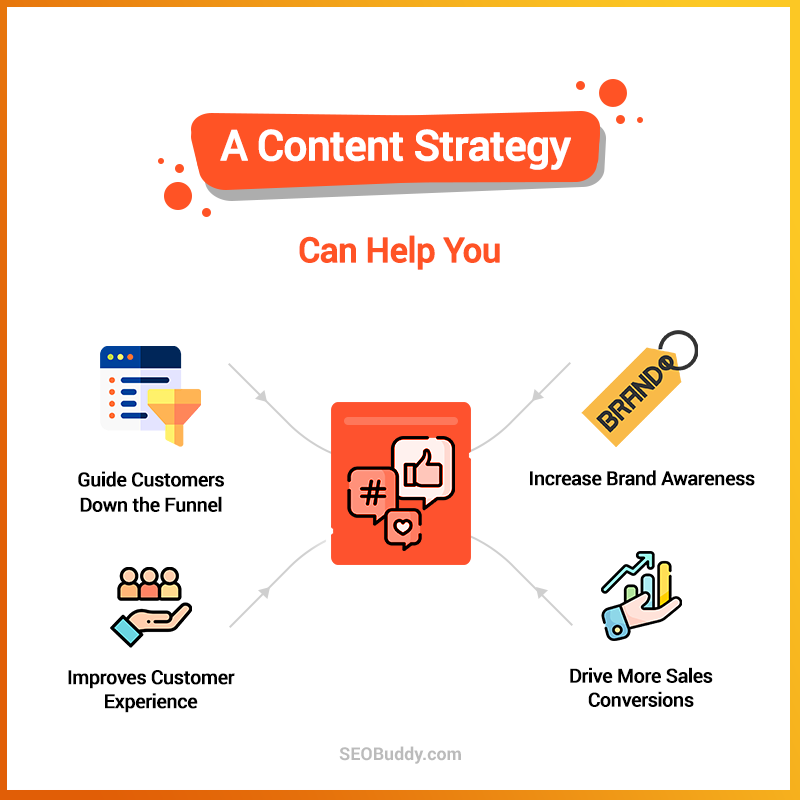
1. Guides Customers Through their Buyer Journeys
You can use a content marketing strategy to attract your target audience and keep them engaged at every stage of the sales funnel including:
- Awareness
- Consideration
- Conversion
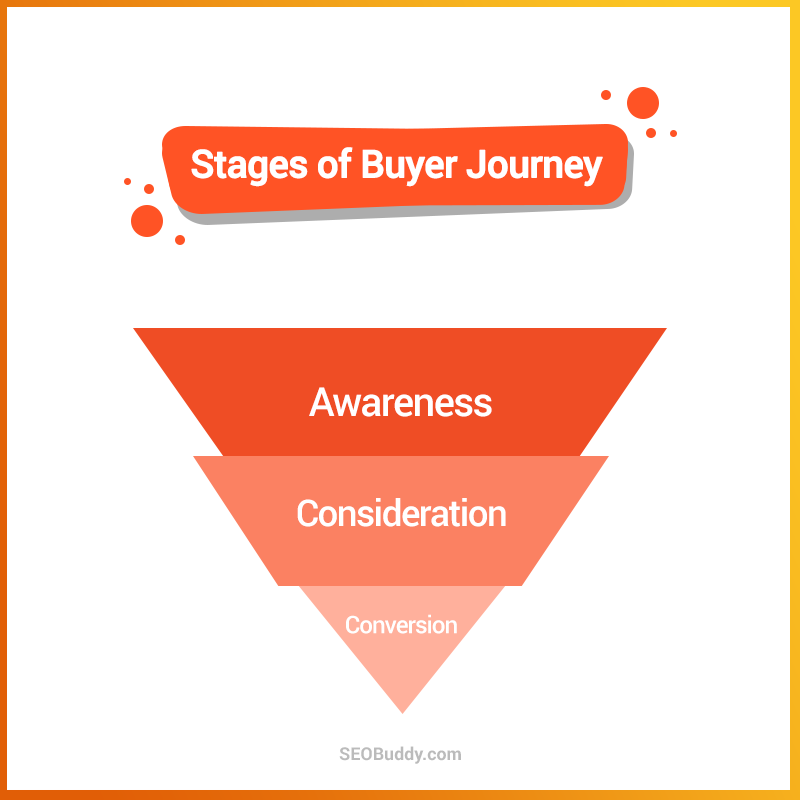
There are several types of content you can plan for in your content strategy targeted at customers at specific stages of their buyer journey.
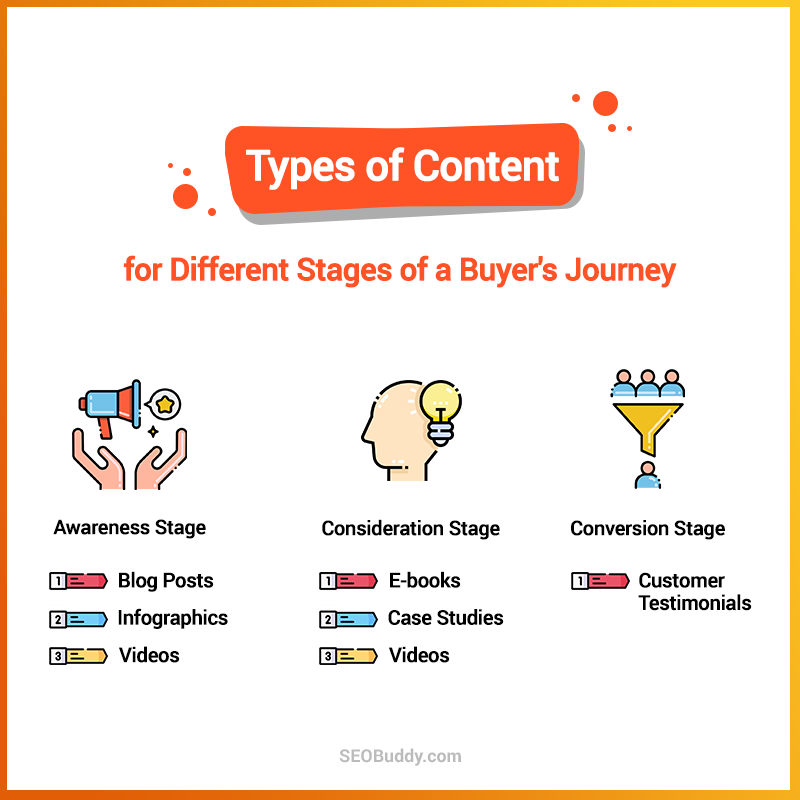
Blog Posts – Awareness Stage
Blog posts are articles written by an industry expert. They contain valuable content that’s educational in nature.
These articles are excellent for the awareness stage of the buyer’s journey, where you need to attract and delight potential customers.
The goal of your content strategy here will be to create blog posts that direct the readers to a solution for their problems.
Optimize the blog content for search engines using SEO tactics to make it easily discoverable to new audiences and increase website traffic.
Here is an example of a quick search on “how to feed a Rottweiler dog”. The purpose of the search is to find a solution on how to feed the said dog breed.
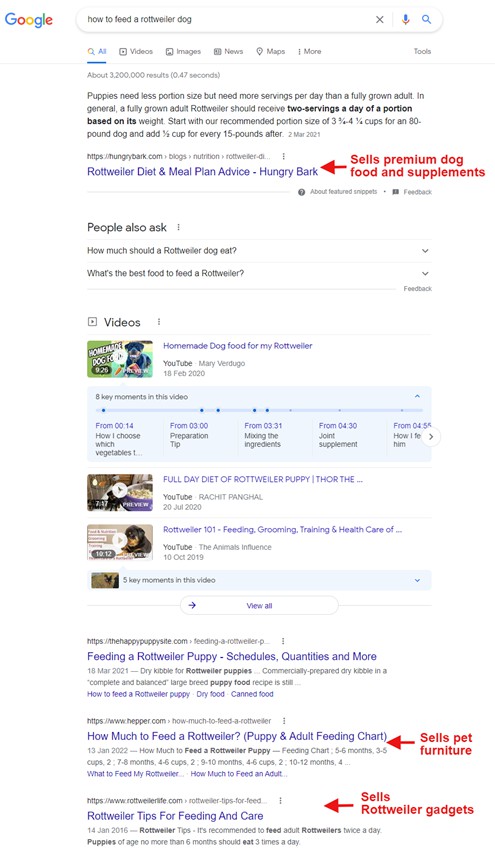
Three out of four of the top search results are articles from companies selling products in the pet industry. They use informative blog posts to attract prospects who would potentially buy those products.
Infographics – Awareness Stage
Infographics organize complex data in a beautiful visual that’s easier for the brain to process. These are great for attracting customers at the awareness stage.
Here is an example of an infographic explaining why you should use the Google Keyword Planner.
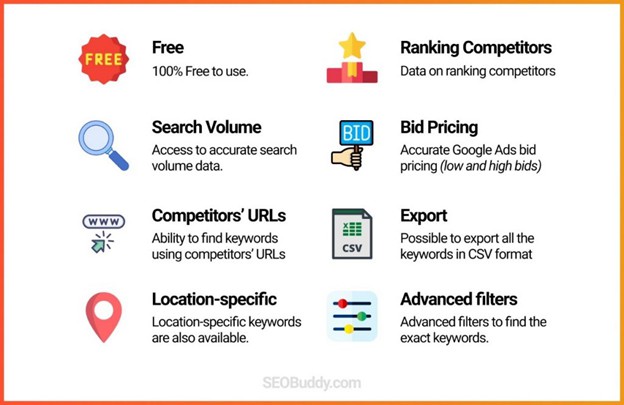
Notice how it makes the info easier to consume?
That’s the beauty of infographics.
E-Books – Consideration Stage
After reading a blog post, a reader may want more information, this is where an e-book comes in.
Like blog posts, e-books are great for buyers in the initial stages of the sales funnel. They are typically longer than blog articles and cover a topic in depth.
E-books are also an excellent lead magnet.
A reader who already knows from your blog post that you’re an expert in the field will not have a problem providing their contact information to download the e-book.
Here is an example of an e-book from Salesforce. It’s on the same page as a blog post but offers a more in-depth guide on the same topic.
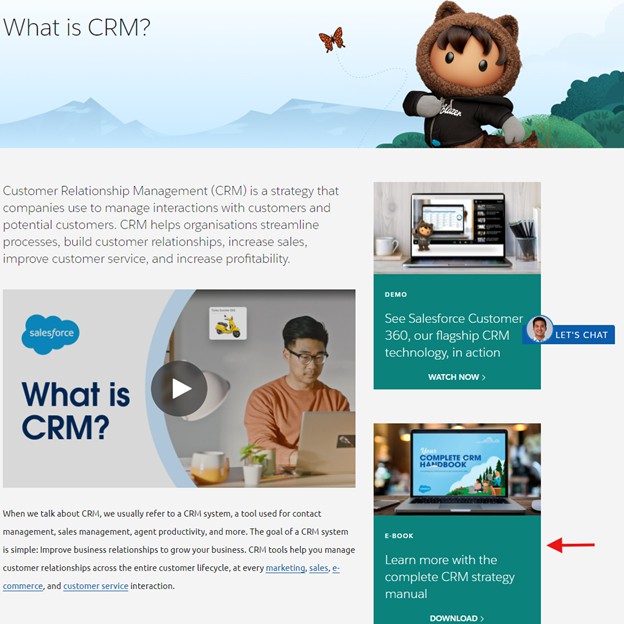
Case Studies – Consideration Stage
Once you use blog posts and e-books to prove to potential customers that you’re worth your salt, case studies will give them the nudge necessary to convert them.
A case study is ideal for customers in the consideration stage.
You use it to tell a customer story, and in the process, build trust in your brand.
A case study demonstrates the problem your product helped a real-life customer resolve. It should also contain details about the improvements the individual or business experienced as a result of using your product or service
These details differentiate you from your competition and push the customer further down the funnel.
Here is an example of a case study from CoSchedule.
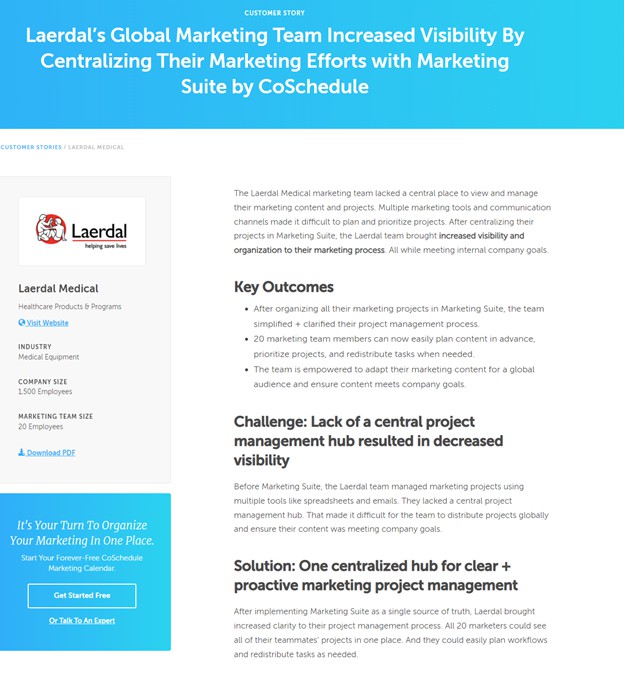
Videos – All Stages
The modern customer is more attuned to video content than ever before, and the number of digital video viewers worldwide is growing by the day.
According to Statista, there will be 3.48 billion online video viewers in 2023 compared to 3.26 billion viewers in 2021.
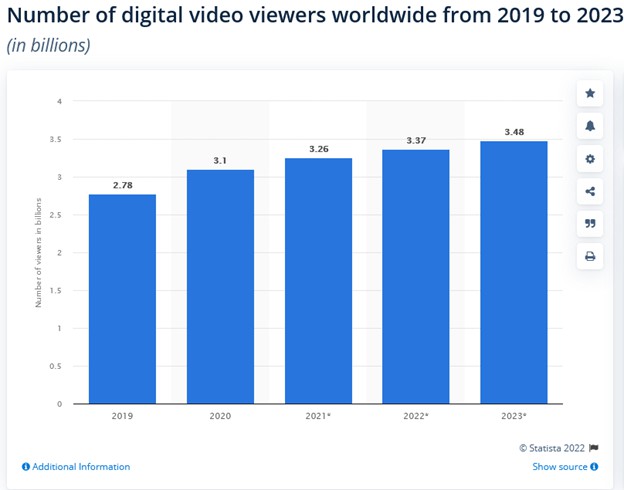
For customers in the awareness stage, you can create a video series that:
- Provides helpful information about a certain topic that matters to your target customers
- Addresses a problem or pain point
- Entertains them
Product tutorials are great for customers in the consideration stage. Educate customers on how your product can solve their problems.
As the customer gets closer to conversion, video testimonials, product demos, video case studies, and content marketing case studies will be a good fit.
For customers who’ve already converted, you can use feature update videos and new product announcement videos to keep them interested.
2. Increases Brand Awareness
If your business goal is increasing brand awareness, SEO will be an important factor in your content strategy.
It’ll increase your brand’s visibility on search engine result pages.
There’s a lot that goes into optimizing content for search engines, we’ll not cover it all here. But we’ve made things simple for you by creating a comprehensive SEO checklist you can use to get your website on the first page of Google.
A successful SEO strategy will be indicated by:
- An increase in organic search traffic
- Increase in he number of times your site shows up in search results, even when no one clicks on it
- Increase in the number of keywords your site is ranking for
- An improvement in your website’s domain authority
Here are two pointers to achieve maximum SEO impact from your content strategy.
1. Pick the right keywords
Choosing the right keywords will put your content in front of the right audience.
Get the right keywords by:
- Studying the competition: What are the keywords they are ranking for?
- Making use of long-tail keywords: They are more specific than short-tail keywords and will expose your brand to people who are more likely to convert.
- Choosing keywords that you’re likely to rank for on Google based on your website’s authority.
But simply using the right keywords in your content will not cut it. You need to match the search intent as well.
What is search intent?
It’s the reason why a user searches for a query on a search engine. Here’s a brief overview of the four types of search intent.
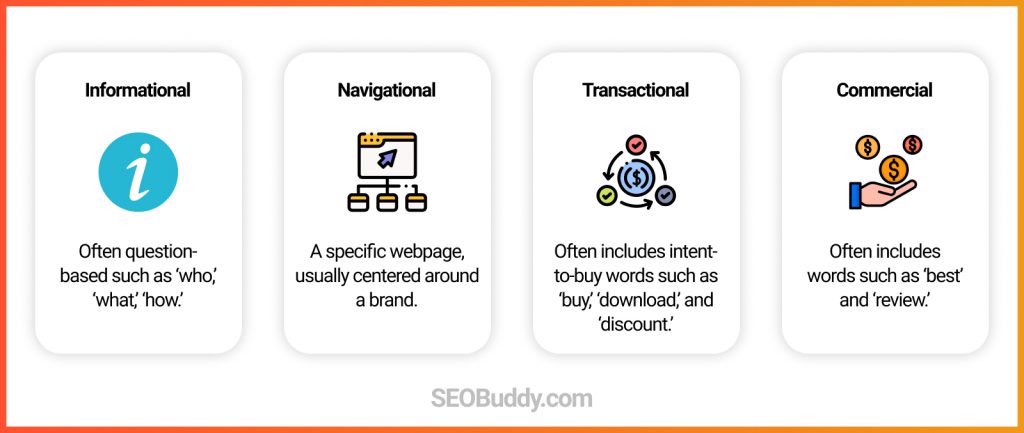
A keyword research tool like Semrush can help you get the data you need on a keyword’s search volume, intent, keyword difficulty, competition level, keyword variations, and more.
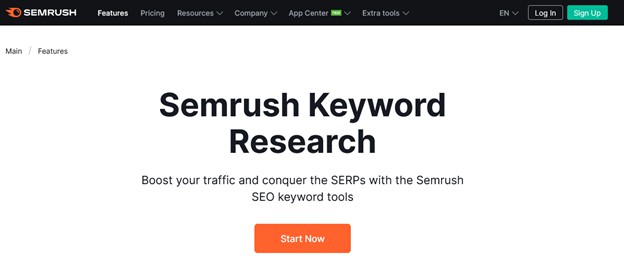
There are also free SEO tools you can use like the Google Keyword Planner.
2. Create Content Clusters
A cluster page helps you optimize your website’s structure and internal linking, which in turn gives you an SEO boost.
It creates pillar and cluster pages that organize your content based on how relevant it is to a given topic.
Here’s what it entails.
You’ll need pillar content. This is content that covers every aspect of a core topic, comprehensively. It addresses any question the reader could have regarding the topic.
You’ll then have cluster content, which are articles or pages that talk about individual sub-topics or key aspects in the pillar page in detail.
Cluster content will be rich in keyword phrases in its respective sub-topic.
Finally, you’ll use internal linking in your pillar content to link out to the individual cluster pages. Where relevant, the cluster pages can also link to each other.
Here is what we mean:
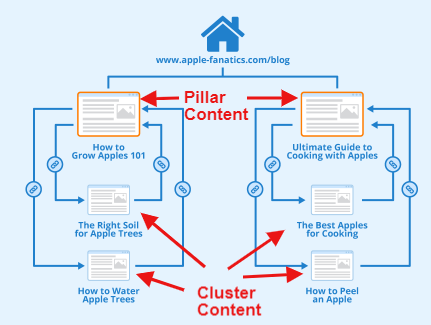
Why go through all this trouble?
A pillar-cluster model shows search engines your expertise and authority in a field, and this improves your ranking on search engine results pages.
3. Improves Customer Experience
You can use educational content to prevent too many inbound customer service requests and improve customer success.
What is customer success?
It means anticipating challenges a customer may have and proactively providing solutions, in this case using an effective content strategy.
It ensures that the customer achieves their desired outcomes using your product.
The kind of content you create will involve educating, training, and teaching customers how to use your product and get the most out of it.
To know if your content strategy has met your business objective, check for a reduction in support tickets and an increase in customer retention.
With content doing half the work for them, your customer service team will have more time to focus on addressing significant issues that content alone cannot resolve.
For instance, BigCommerce has created a rich knowledge base that contains user docs, guides, FAQs, and videos that contain all a customer needs to set up their BigCommerce store and get it running.
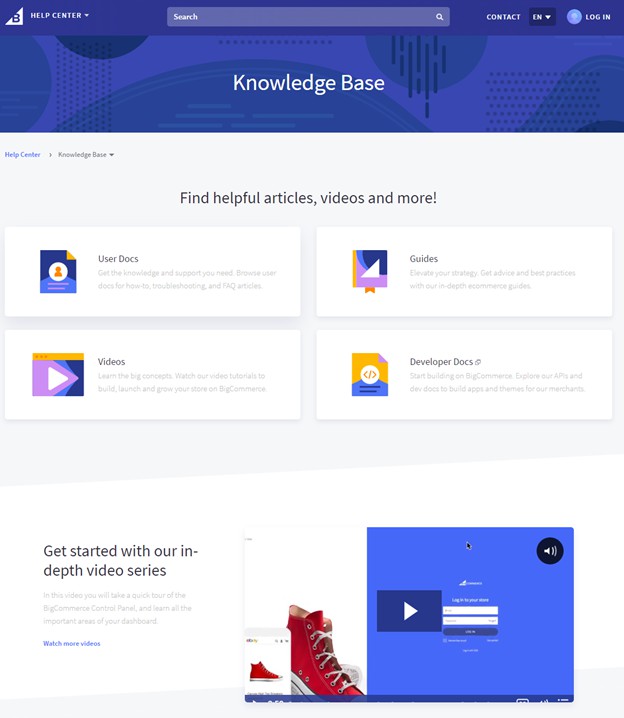
And for customers looking for specialized training about the BigCommerce platform, there is a university designed to offer self-paced courses.
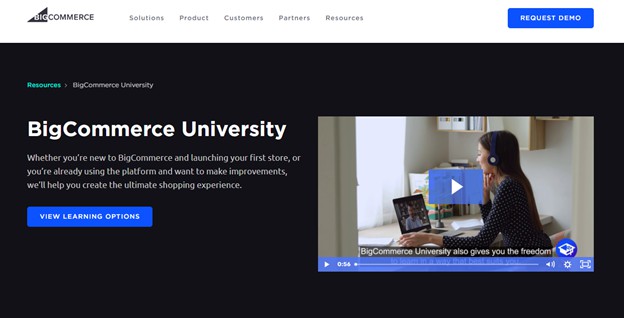
4. Drives More Sales Conversions
Your content strategy can also empower your sales team with the tools they need to build a case for buying your products or services.
This will require content that addresses the common questions and objections your sales team gets from potential customers.
For instance, if you’re providing a software solution most customers may question its ease of integration with other software the customers may have.
What you can do in such a case is create content that addresses how seamlessly your solution integrates with other common tools and software.
Or create guides on how customers can fit your software solution within their existing business processes.
A successful content strategy for sales enablement will be indicated by the increase in conversions rates.

Now it’s time to discover the other 102 steps that will get more organic traffic flowing to your website. Get the SEO Checklist here.
Want to get a sneak peek of what it looks like?
Enter your email and get a free demo version of the SEO Checklist.
How to Develop an Effective Content Strategy
Here are the six steps of developing a successful content strategy for your business.
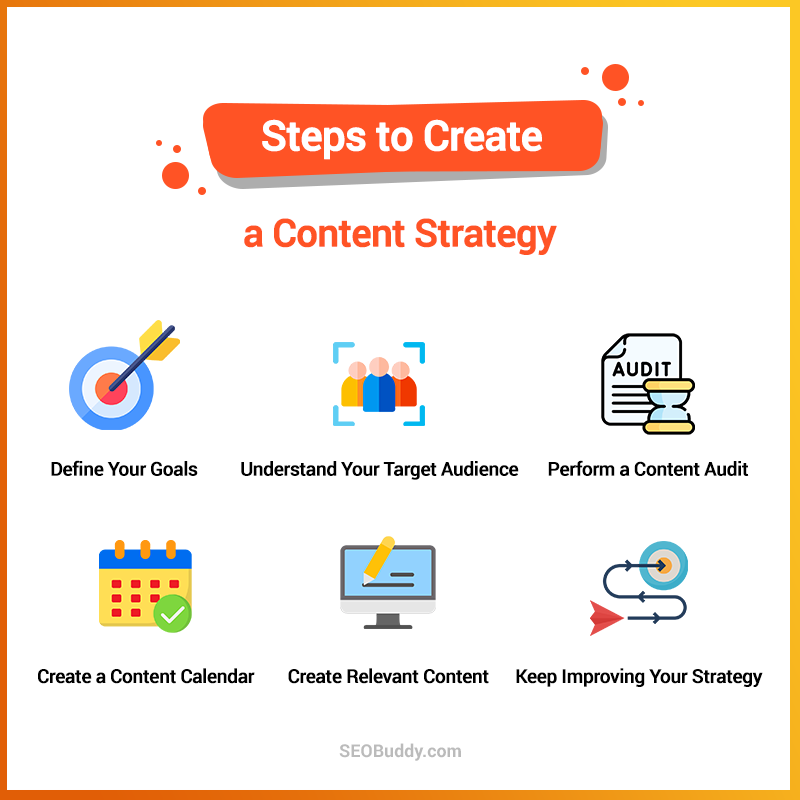
Step 1: Define Your Goals
It goes without saying that the first step in creating a content marketing strategy is to identify the business goals you want to achieve.
Knowing your reasons for creating a content strategy, will make it easier to create one that can help you achieve those business goals.
You should also identify metrics that you can use to measure your performance on these goals.
Step 2: Understand Your Target Audience
Before creating content, know who your target audience is and what they like. Conducting audience persona research is important to understand what kind of content you should create and about which topics.
Understanding your target audience will help you create relevant content that’ll they’ll enjoy reading.
Here is a starting point: create a buyer persona.
A buyer persona is a model of your ideal customer or a fictional representation of who they are.
The persona information is based on conducting market research, gathering data from existing customers, and making some educated assumptions.
It includes details like:
- Age
- Gender
- Interests and hobbies
- Income level
- Occupation
- Location
- Behavioral traits
- Challenges
- Goals
- And a lot more
Here are two ways you can do audience research.
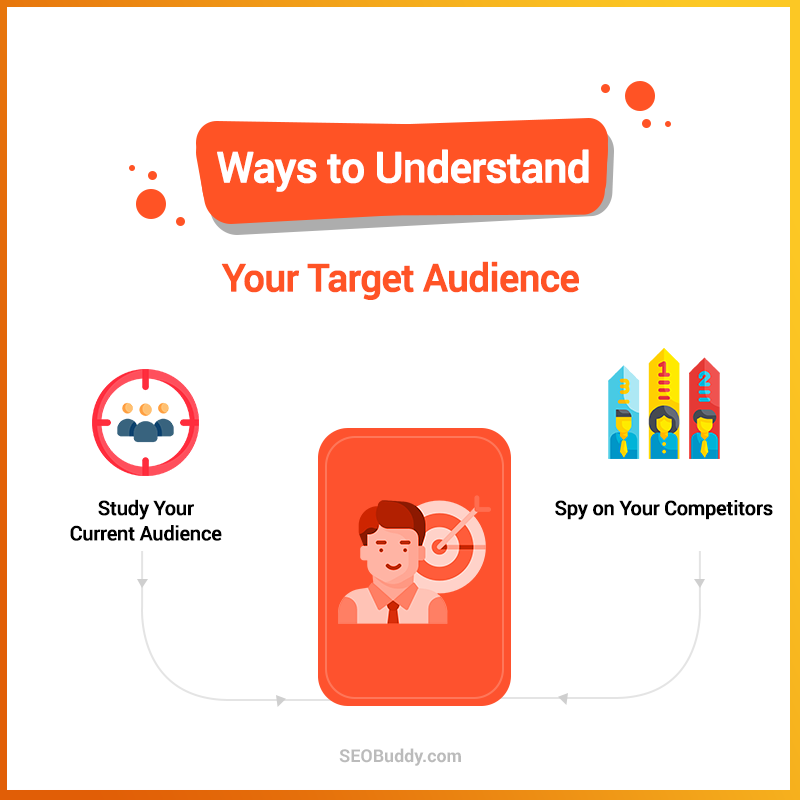
1. Study Your Current Audience
Understanding your current audience can give you an insight into who your target audience is.
- Use surveys, questionnaires, and interviews to find out what their needs or wants are.
- What are the demographics of your customers and leads? What is their purchasing behavior?
- Look at their website engagement, this includes details like the pages they visit and how long they spend on your web pages.
All these details will paint a picture of who you should be writing for.
2. Spy on Your Competitors
Spy on your competitors:
- Check the people engaging with their social media accounts.
- Observe the people leaving customer reviews for their products and services
- Check their blog comments
These methods of keeping tabs on your competitors will reveal details about what their audience likes and dislikes about these brands.
Use these audience insights to perfect your content strategy.
You don’t have to work with one persona. You can segment your target market based on location, behavior, or any other relevant factors.
Segmentation will help you deliver more personalized content that’ll meet your target audience’s needs better.
Step 3: Perform a Content Audit
Next step for creating a content strategy is to conduct a content audit.
What is a content audit?
It’s a qualitative analysis of all the content on your website or social media channels. It’ll help you understand what types of content perform best with your audience and get the most engagement, which don’t.
From here, you can know which direction to take in terms of the kind of content that resonates best with potential customers.
Use this to choose the right types of content for your content strategy and prioritize those for your next content marketing campaign.
Step 4: Create a Content Calendar
It’s time to brainstorm content ideas that’ll help you reach your marketing goals.
There are several tools you can use to get started.
For instance, you can use Feedly to get important insights on topics relevant to your niche. You’ll get updates from blogs, news websites, and other reliable sources.
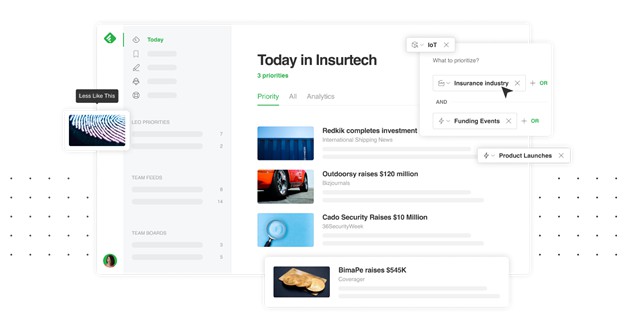
You can also use BuzzSumo to find popular content ideas and get meaningful insights from trending articles in your niche.
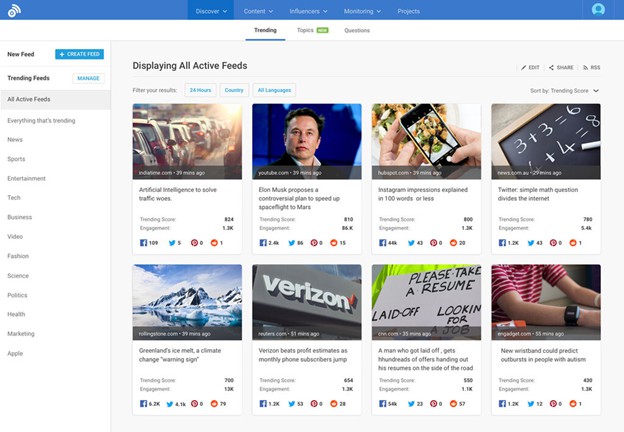
Find content ideas that will most resonate with your audience and organize your ideas in a content calendar.
A content or editorial calendar is a tool that marketers use to plan for upcoming content creation and distribution. You can use it to streamline your team’s content production workflows.
It also lets you keep track of publishing dates so that you post consistently according to a set schedule.
Step 5: Create Relevant Content
When it comes to creating content, it’s important to balance between creating user-centered content and writing on topics that are within your area of expertise.
Set yourself apart as an authority in your industry while also staying relevant to your readers’ needs.
As you create your content, include focus keywords that are relevant to your target audience. Use them in the:
- Title tag
- Heading and subheadings
- Meta description
- First 2-3 lines
- Throughout your content
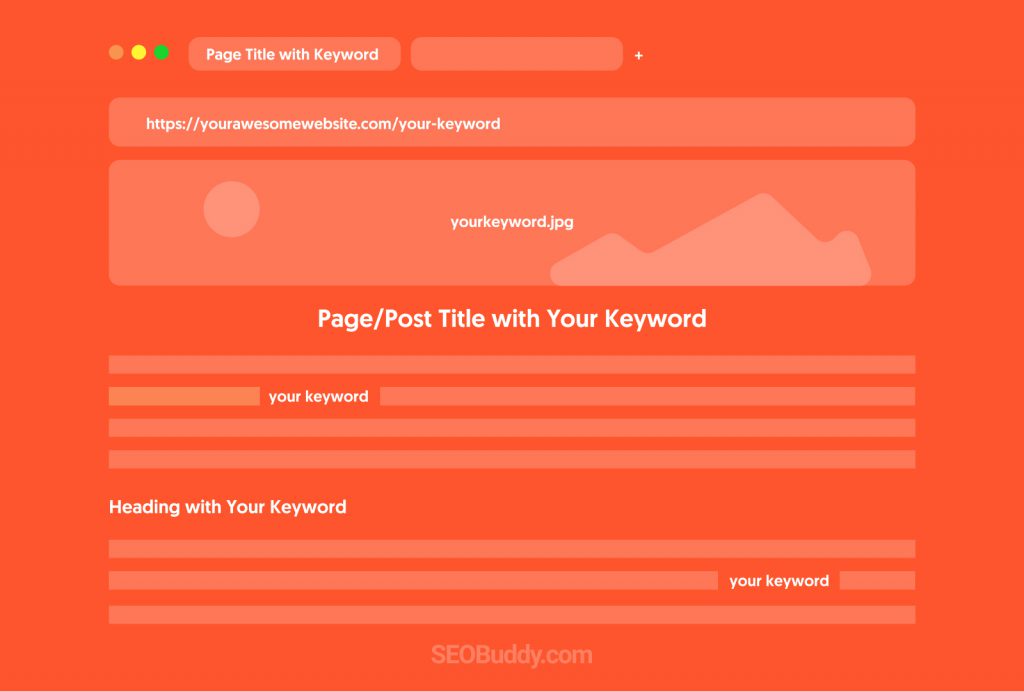
Incorporate relevant LSI (Latent Semantic Indexing) keywords throughout your content as well.
Optimizing your content will increase the chances of a higher rank on search engine result pages and that’ll increase organic traffic.
Step 6: Keep Improving Your Strategy
Content creation is an ongoing process.
It’s important to constantly update the content with new research findings and data. Better yet, create more evergreen content that will bring you a steady stream of traffic for years to come.
You’ll also need to regularly check old content for broken links and replace them with new links.
Google updates its algorithms frequently. It’s important to keep up with these changes to ensure your content is always optimized and updated.
Keep evolving your content strategy to accommodate new trends and changes, and ensure that it stays relevant.
FAQs
1. What content formats should I use in my content strategy?
When choosing a content format for your content strategy, prioritize the ones that your existing audience responds to the most.
Also, keep in mind which kind of content to use for prospects at different stages of their buyer journey.
For instance, blog posts are best suited for people in the awareness stage while case studies work well for prospects in the consideration stage.
2. What are the best channels to publish content?
Where you publish your content will depend on where your target audience spends most of the time.
If your audience prefers long videos, you can use YouTube, if they prefer written text, you can publish it on your website and so on.
3. How do you develop a content strategy?
Six steps are essential in developing a good content strategy that meets your organization’s goals:
- Set your goals
- Identify your target audience
- Do a content audit
- Create an editorial calendar
- Create quality content
- Update content regularly
4. Why do I need a content strategy?
A documented content strategy gives a solid direction to your content creation and distribution process. It lays down the plan for what kind of content to create, whom to target, and which channels to use.
5. What do I need to become a good content strategist?
The work of a content strategist involves creating and executing a business’s content strategy across various marketing channels.
A good content strategist needs:
- Good copywriting skills
- A strong grip on SEO
- Editorial skills
- Empathy to recognize what the audience needs
- An analytical mind
Ready to Design the Perfect Content Strategy?
You now have an in-depth understanding of what a content strategy is and how you can use it to achieve your business objectives.
But creating an effective content strategy is not a cakewalk..
Here’s a quick revision of our guide on how to create a winning content strategy:
- Define your goals
- Understand your target audience
- Audit your existing content
- Organize your content ideas in an editorial calendar
- Create SEO-friendly, targeted, and usable content
- Regularly update your content
Do you need help increasing organic search traffic, generating leads, and ultimately increasing your turnover and profitability? Do not hesitate to contact us and let our team of content marketing and SEO experts drive your business towards success.



